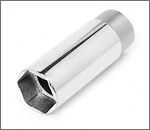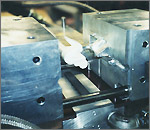Introduction: Thin wall casting the in thing in today's metal casting industry. Due to environment pressure and economic issues, the automobile industry in particular is on the look out for

lightweight, strong and fuel efficient castings. In response to the growing demands, foundries have come up with innovative techniques to cast thin wall casting as thin as 2 mm.
Both is the military and commercial sector new and innovative method are being evolved to cast the thin, lightweight and economical viable casting. Some foundries use a combination of casting methods like the nobake, cold box and shell casting process to cast thin walled casting. By pushing the limits of imagination
thin wall casting with complex designs, high mechanical properties and sound structures can be manufactured.
Casting Process: Different types of complex designed, durable, strong, environment friendly, and economical thin wall casting produced around the world. The main factors that are kept in check while thin wall casting are the metallurgical treatment of the metal; mold and core making techniques; the solidification method for the molten metal, etc. Owing to their metallurgical properties metal like titanium, ductile iron, graphite iron, gray iron, etc. are used for thin wall casting.
Thin wall casting methods and materials change from foundries to foundries. One of thing wall casting methods is as follows:

Firstly, patterns are made of synthetic or natural wax. The wax is injected molded into the dies. Different part of the wax pattern and the gating system are fixed together. The pattern in now dipped in the molding slurry, repeatedly, until the required thickness for the mold in attained. Mold can be made of ceramic, which is made of a mixture of fused silica, zircon and other refractory materials. The molding mixture may contain other substance like wetting agents to control pattern wetting and flow characteristics. While making the mold, the mold cavity must have a thin forming portion. The cavity should be only as thick as the thicknesses that is required for the desired thin wall casting.
The pattern which is covered with mold forming slurry either heated or treated with solvent in order to dewax the pattern. The melted wax is then drained. Before the molten metal is poured into it, the mold is preheated close to the melting temperature of the metal to be casted. The hot metal in introduced into the mold through the gating. The mold is completely filled and solidified. Foundries use different techniques to avoid the void between the molten and the solidified metals. On solidification the casting is removed from the mold.
Methods to improve quality of thin wall casting
- Molding materials used should give high degree of dimensional accuracy
- Gating system should be designed to allow the mold to fill completely
- Shrinkage can be controlled by maintaining a proper temperature
Application: Thin wall casting is growing in demand both for military and commercial applications. Thin walls are applicable not only for casting automobile and aircraft parts, but for other component also. Presently, automobile industry use thin wall casting for passenger cars, trucks, farm equipment and other commercial vehicles.
Component that are thin wall casted are turbine engine component, titanium nose cap for engine pylons, spark plug socket, complex engine structures, etc. Different types of alloy are being experimented for thin wall casting. Of now casting are made from titanium, ductile iron, graphite iron, gray iron, etc.
Advantages of Thin Wall Casting:
- Thin wall castings used in cars and trucks should result is 5% fuel consumption
- Allows vehicles to be completely lightweight
- Thin wall casting is a best solution for environment friendly and economical casted components.


